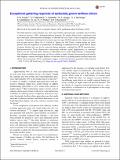| dc.contributor.author | Markevich, V. P. | |
| dc.contributor.author | Castellanos, S. | |
| dc.contributor.author | Lai, B. | |
| dc.contributor.author | Peaker, A. R. | |
| dc.contributor.author | Buonassisi, T. | |
| dc.contributor.author | Powell, Douglas Michael | |
| dc.contributor.author | Hofstetter, Jasmin | |
| dc.contributor.author | Jensen, Mallory Ann | |
| dc.contributor.author | Morishige, Ashley Elizabeth | |
| dc.date.accessioned | 2018-11-05T20:40:23Z | |
| dc.date.available | 2018-11-05T20:40:23Z | |
| dc.date.issued | 2016-02 | |
| dc.date.submitted | 2015-11 | |
| dc.identifier.issn | 0021-8979 | |
| dc.identifier.issn | 1089-7550 | |
| dc.identifier.uri | http://hdl.handle.net/1721.1/118899 | |
| dc.description.abstract | The bulk minority-carrier lifetime in p-And n-type kerfless epitaxial (epi) crystalline silicon wafers is shown to increase >500× during phosphorus gettering. We employ kinetic defect simulations and microstructural characterization techniques to elucidate the root cause of this exceptional gettering response. Simulations and deep-level transient spectroscopy (DLTS) indicate that a high concentration of point defects (likely Pt) is "locked in" during fast (60 °C/min) cooling during epi wafer growth. The fine dispersion of moderately fast-diffusing recombination-active point defects limits as-grown lifetime but can also be removed during gettering, confirmed by DLTS measurements. Synchrotron-based X-ray fluorescence microscopy indicates metal agglomerates at structural defects, yet the structural defect density is sufficiently low to enable high lifetimes. Consequently, after phosphorus diffusion gettering, epi silicon exhibits a higher lifetime than materials with similar bulk impurity contents but higher densities of structural defects, including multicrystalline ingot and ribbon silicon materials. Device simulations suggest a solar-cell efficiency potential of this material >23%. | en_US |
| dc.description.sponsorship | United States. Department of Energy (Contract DE-EE0005314) | en_US |
| dc.description.sponsorship | United States. Department of Energy (Contract EEC-1041895) | en_US |
| dc.description.sponsorship | National Science Foundation (U.S.) (Contract EEC-1041895) | en_US |
| dc.publisher | American Institute of Physics (AIP) | en_US |
| dc.relation.isversionof | http://dx.doi.org/10.1063/1.4940947 | en_US |
| dc.rights | Article is made available in accordance with the publisher's policy and may be subject to US copyright law. Please refer to the publisher's site for terms of use. | en_US |
| dc.source | Other repository | en_US |
| dc.title | Exceptional gettering response of epitaxially grown kerfless silicon | en_US |
| dc.type | Article | en_US |
| dc.identifier.citation | Powell, D. M. et al. “Exceptional Gettering Response of Epitaxially Grown Kerfless Silicon.” Journal of Applied Physics 119, 6 (February 2016): 065101 © 2016 AIP Publishing LLC | en_US |
| dc.contributor.department | Massachusetts Institute of Technology. Department of Mechanical Engineering | en_US |
| dc.contributor.mitauthor | Powell, Douglas Michael | |
| dc.contributor.mitauthor | Hofstetter, Jasmin | |
| dc.contributor.mitauthor | Jensen, Mallory Ann | |
| dc.contributor.mitauthor | Morishige, Ashley Elizabeth | |
| dc.relation.journal | Journal of Applied Physics | en_US |
| dc.eprint.version | Final published version | en_US |
| dc.type.uri | http://purl.org/eprint/type/JournalArticle | en_US |
| eprint.status | http://purl.org/eprint/status/PeerReviewed | en_US |
| dc.date.updated | 2018-11-01T14:00:45Z | |
| dspace.orderedauthors | Powell, D. M.; Markevich, V. P.; Hofstetter, J.; Jensen, M. A.; Morishige, A. E.; Castellanos, S.; Lai, B.; Peaker, A. R.; Buonassisi, T. | en_US |
| dspace.embargo.terms | N | en_US |
| dc.identifier.orcid | https://orcid.org/0000-0002-5353-0780 | |
| dc.identifier.orcid | https://orcid.org/0000-0001-9352-8741 | |
| mit.license | PUBLISHER_POLICY | en_US |
